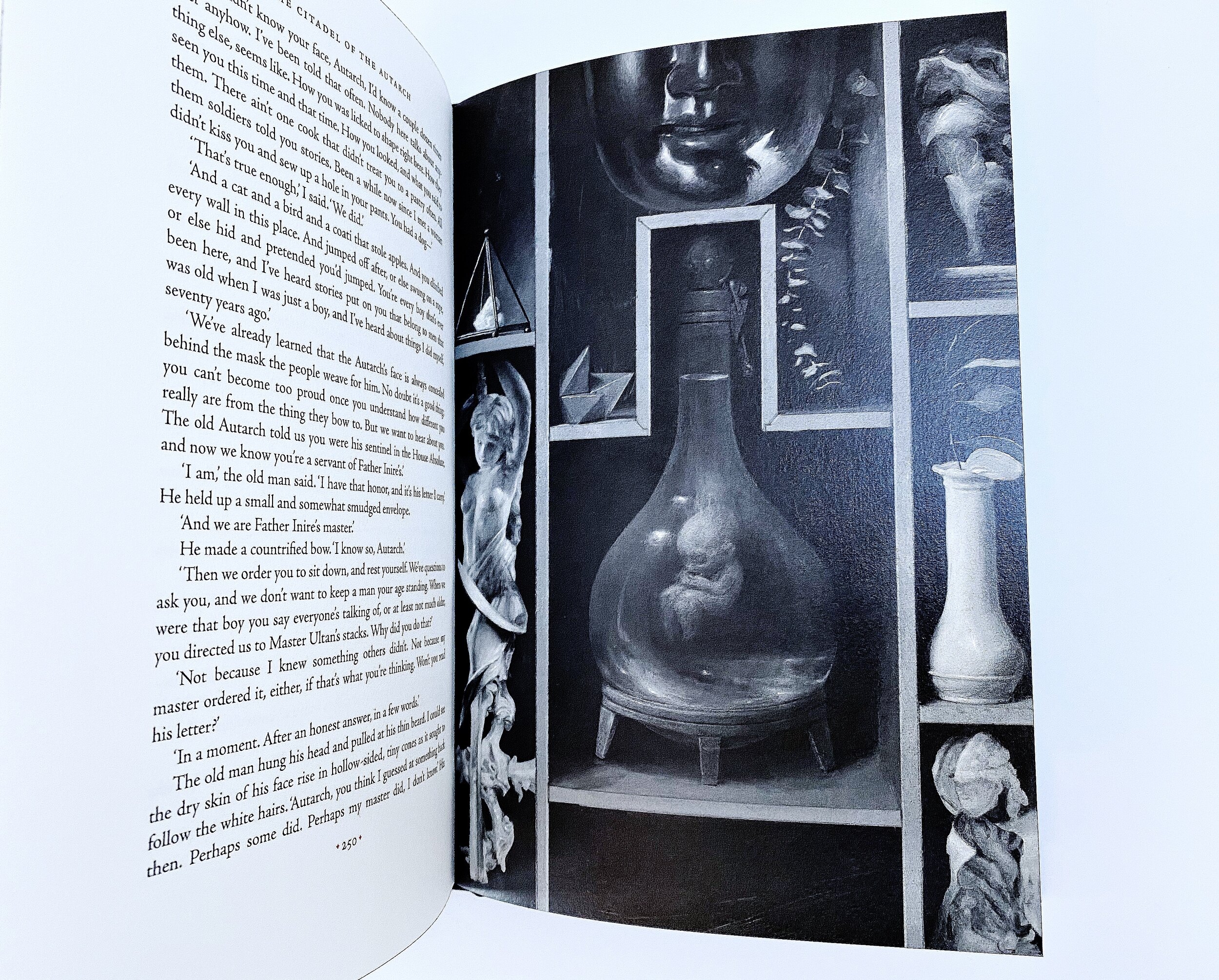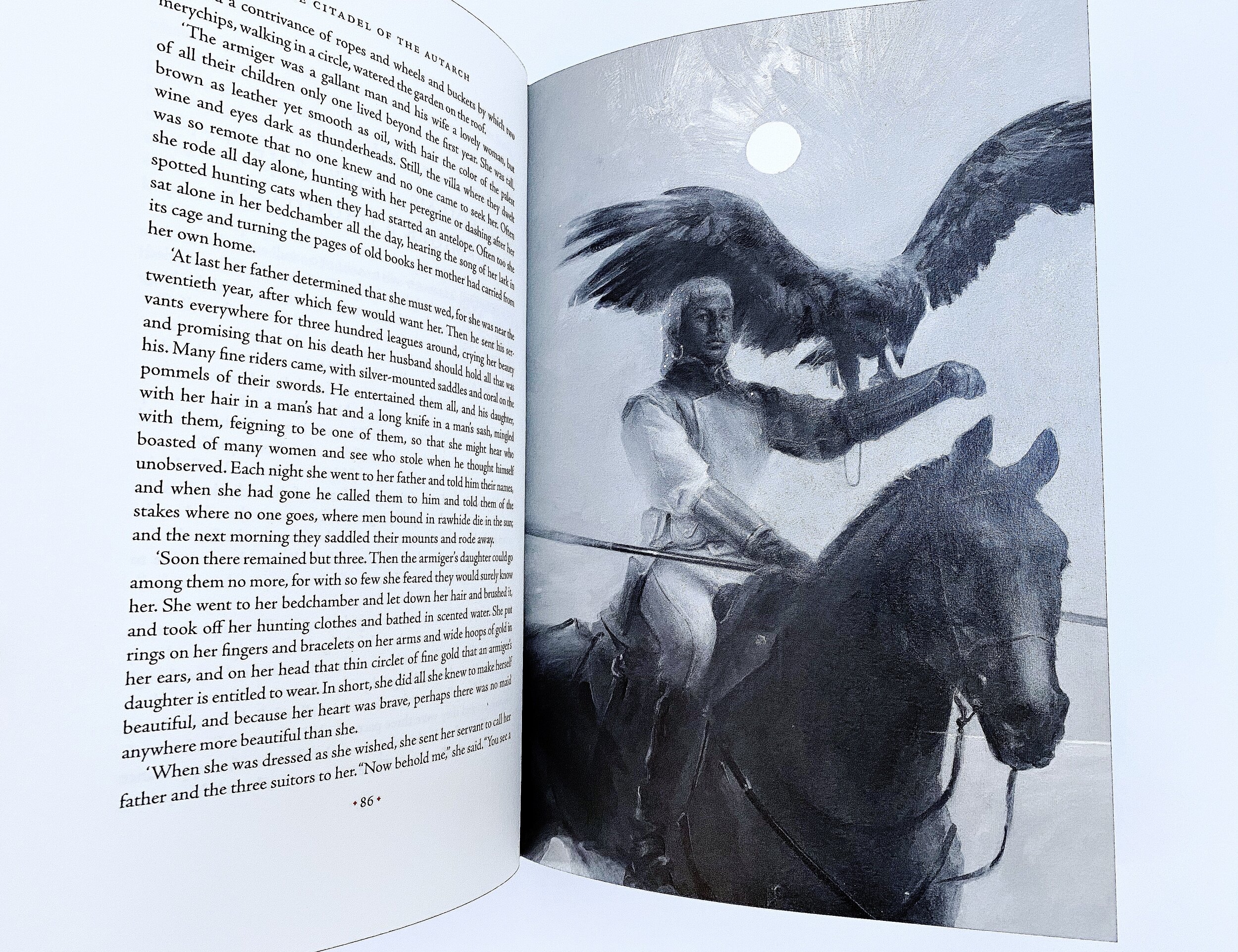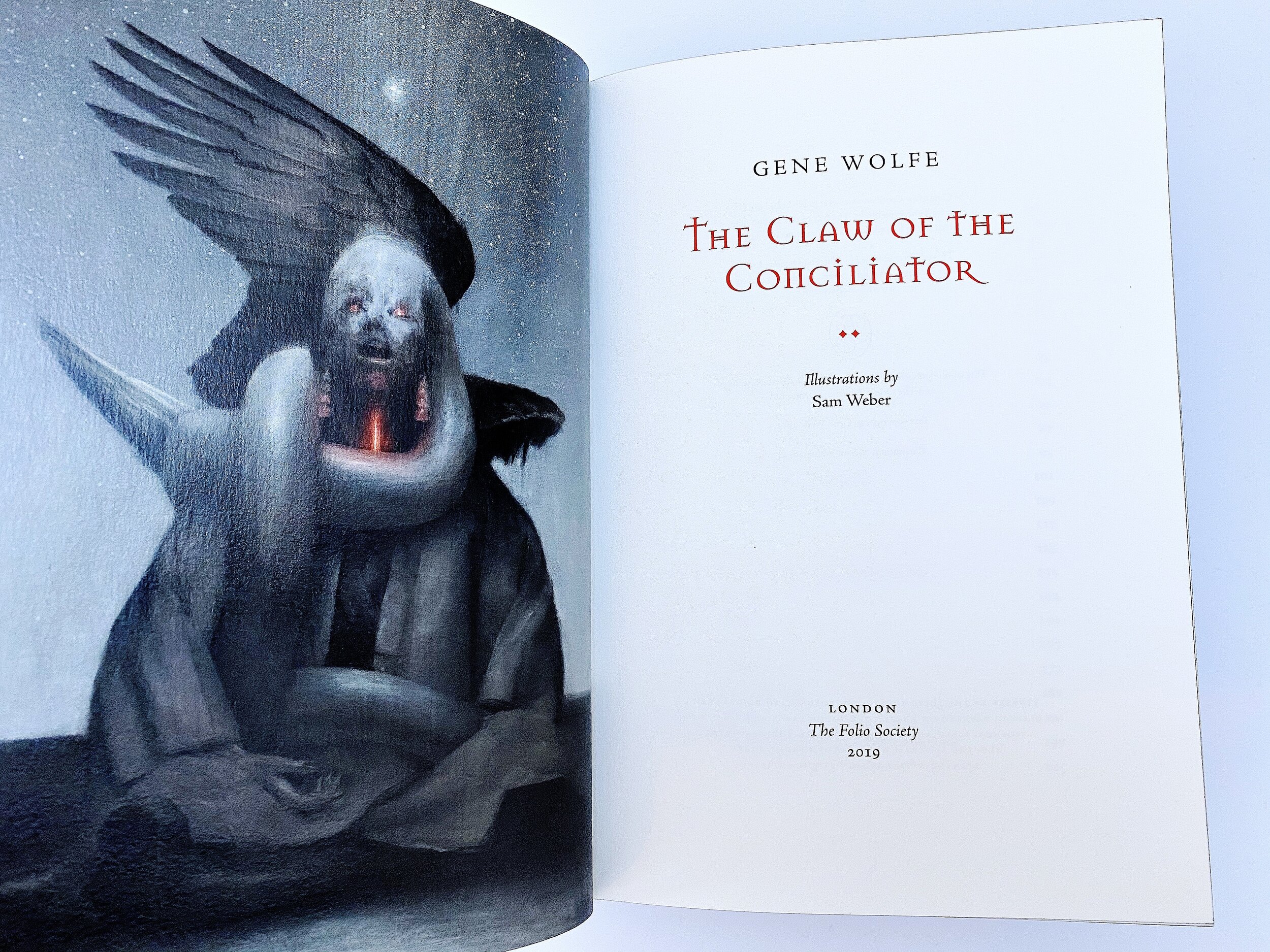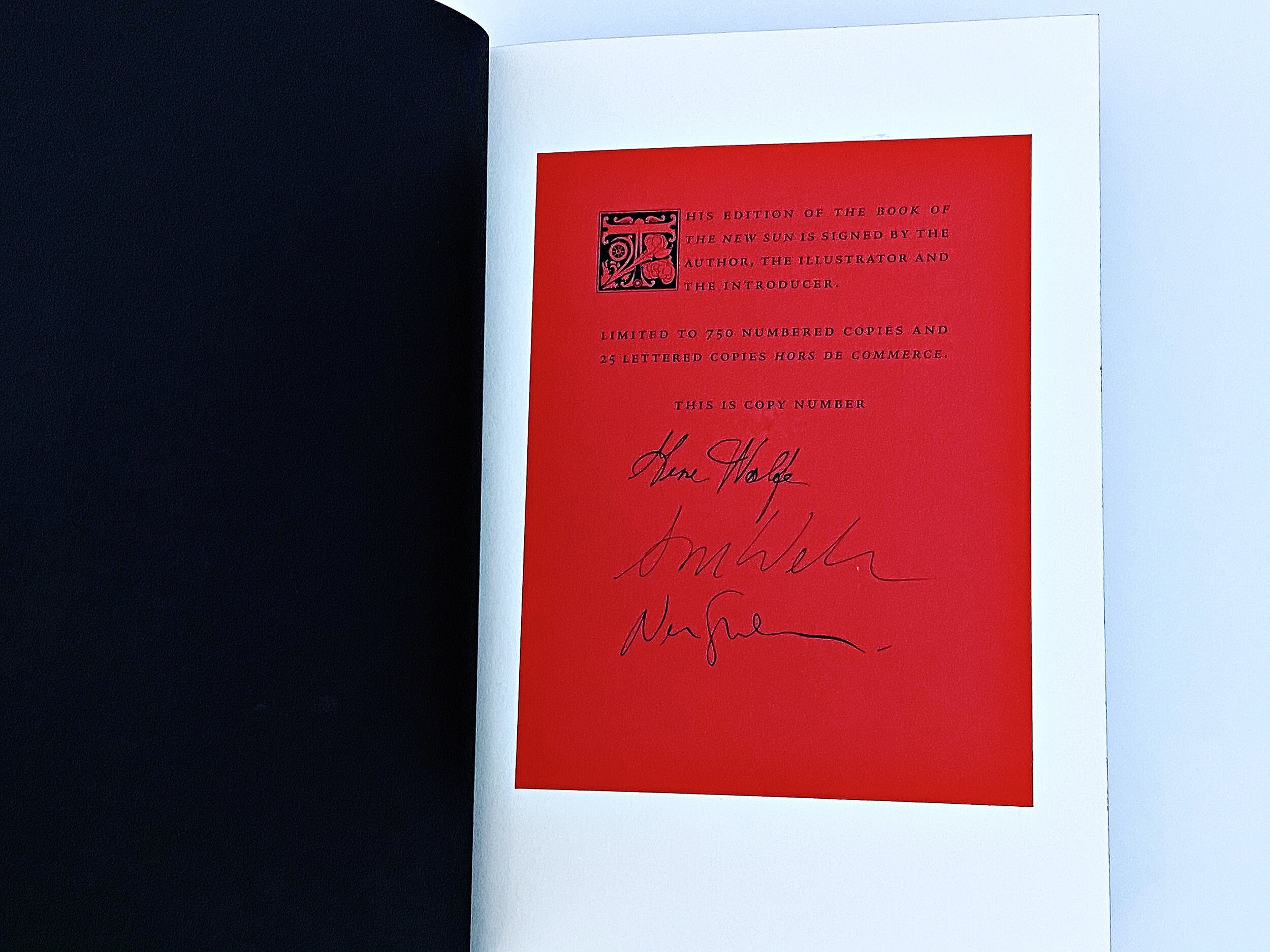Of Wolfs, Ghouls and The Book of the New Sun
I have been waiting to share this with you for many moons. Like many others before me, I have travelled through a strange and foreign land - and now almost arrived at the end of Gene Wolfe’s The Book of the New Sun saga. Thank you to my good friend A.A., with whom I read these books in parallel and who never tired of discussing its mesmerising labyrinth. Thank you also to everyone who has left their mark on the trail before, and the many good books that have been written about the magnum opus of one of the most underestimated science fantasy authors of our time. Finally, thank you in particular to the Folio Society and the amazing Sam Weber, whose art adorns this limited fine edition of Wolfe’s masterpiece (see his making-of video below | all other pictures taken from my personal set).
If you have never heard of this fantastic book before, I hope this short piece can lure you into it. If you have traversed it long before myself, I welcome you as a friend.
LVX,
Frater Acher
May the Serpent bite its tail.
I. Not a Book Review.
With regards to uniqueness of vision, style, and execution, Gene Wolfe in his four volume fantasy-masterwork The Book of the New Sun (+ the fifth volume: The Sun of the New Urth) puts most modern fantasy authors to shame. In thirty years of reading experience, I have never come across such precision as well as density of groundbreaking ideas captured on paper, and woven into one magical canon. While on the surface accepting the literary genre rules of 1980s science fantasy, Wolfe's cycle can be considered the very definition of unconventional writing. More directly, Wolfe's book should be understood as a full frontal attack on any kind of traditional literary genre expectations. The author's imagination and inventiveness is so wild and exuberant, it seems hard to imagine the pain Wolfe would have experienced himself when reading more traditional genre pieces? Despite the fact that his full cycle spans more than 1200 pages, we can see its author struggling to push the entire vista of this new world - with all its color, cruelty and compassion - through the limitation of the reader's average ability to follow into the unknown. Only in the final and fifth volume of the cycle, Wolfe seems to have loosened these reins slightly, and given in to the sheer animalistic force and power of his vivid visions...
So. What can one say about an epic of such proportions? Of course, we could write an epic book review through a practitioner’s lens - pulling carefully on the many threads of magic woven deeply into the five volumes of The Book of the New Sun. And yet such review would add very little to the actual magic of experiencing these books first hand. More likely, it would only take away from it. So instead of attempting to compress the mesmerising kaleidoscope that this epic journey presents into online fast-food, we will focus on one single aspect, a short but piercing gaze through a keyhole into its cosmos alone. For the exploration of the many horizons beyond that door, we all need to turn the handle ourself, and step over the threshold of the first page. Now, if you still crave a more in depth review, I recommend this one here; or this general advise on how to best prepare for your personal expedition into the lands of the Urth.
The Book of the New Sun is set on a dying Earth (or Urth), set so far in the future that our Old Sun is dimming and growing cold. The light is less than in our time. The skies in the day are red, not blue. Be aware of things and people that were dead returning to life. That is, after all, where the book be- gins: after a drowning, at the gates of a graveyard. (...) The Book of the New Sun is a hymn to memory, a Borgesian labyrinth crafted into a whole world, a sequence of mirrors and reflections that allow us to travel the universe of a dying Earth that may live again. (Neil Gaiman, in the Introduction to the 2019 Folio Society Edition of Gene Wolfe’s The Book of the New Sun)
II. Meet the Alzabo.
So here is our single, sharp look into the world of Severian the Torturer. We will examine nothing, but one of its most fascinating creatures and the particular magical elixir prepared from it. As we will see, the mythical alzabo holds several significant lessons in store for us which directly apply to our journey as spirit-workers. But first, let's hear from Wolfe himself about this ancient predator:
Much later I was to hear the sound the alzabo makes as it ranges the snowswept tablelands of the high country; its laughter is horrible. (The Claw of the Conciliator)
"Do you know of the analeptic alzabo?” I said, “No, Chatelaine, but I have heard tales of the animal of that name. It is said it can speak, and that it comes by night to a house where a child has died, and cries to be let in.” Thea nodded. “That animal was brought from the stars long ago, as were many other things for the benefit of Urth. It is a beast having no more intelli- gence than a dog, and perhaps less. But it is a devourer of carrion and a clawer at graves, and when it has fed upon human flesh it knows, at least for a time, the speech and ways of human beings. The analeptic alzabo is pre- pared from a gland at the base of the animal’s skull. Do you understand me?” (The Claw of the Conciliator)
The beast that waited there stood upon four legs; even so, its hulking shoulders were as high as my head. Its own head was carried low, with the tips of its ears below the crest of fur that topped its back. In the firelight, its teeth gleamed white and its eyes glowed red. I have seen the eyes of many of these creatures that are supposed to have come from beyond the margin of the world—drawn, as certain philonoists allege, by the death of those whose genesis was here, even as tribes of enchors come slouching with their stone knives and fires into a countryside depopulated by war or dis- ease; but their eyes are the eyes of beasts only. The red orbs of the alzabo were something more, holding neither the intelligence of humankind nor the innocence of the brutes. So a fiend might look, I thought, when it had at last struggled up from the pit of some dark star; then I recalled the man- apes, who were indeed called fiends (...). (The Sword of the Lictor)
III. The Arabic Origins of the Alzabo
Now, let’s start at the beginning: Gene Wolfe derived the name of this mythical beast from the Arabic word for the wolf, which is aldhiyb (الــــــذئــــــب). Despite its obvious difference in notation, phonetically, that is when spoken out loud, aldhiyb will sound like alzabo to Western ears. However, the connection of the alzabo to an Arabian wolf goes beyond the pure outer resemblance.
In ancient Islamic societies the animal realm was closely connected to the realm of the jinn. Julius Wellhausen in his widely published ‘Remains of Arabic Paganism’ (Reste Arabischen Heidentums, 1897) asserted that Islamic ‘zoology is at the same time demonology’; a notion that sounds rather familiar to the student of Ancient Egyptian magic. Thus in Islamic times, being depicted as furry reflected the animalistic side of many jinn (Wellhausen, p.151). However, especially the jinn- species of the necromantic, desert-dwelling, female ghouls was considered to be shape-shifting, and often appeared in various animal forms.
The gūl (gīlān and agwāl in plural forms) amongst the Arab is a female, especially cruel and hostile demon, a variety of the marīde that also belong to the jinn, who by shifting their shapes lead humans, especially travellers, away from their path, and then suddenly attack, kill and devour them. (Hentschel, p.36)
The position of man concerning the ghouls was destitute, and thus the physical territories they were known to roam were avoided as much as possible. If one still had to traverse through lone stretches of desert, one needed protection. One needed an ally mighty enough to ward off the deceitful attacks of the ghouls. The only being fierce enough to do this trick, according to Arabic folklore, was the wolf. But how much did this leave the desert-traveler between a rock and a hard place? Thus the old saying:
‘A brother of the desert has to be friend with the wolf, and familiar with the ghoul.’ (Wellhausen, p.151)
The wolf was believed to be the only animal which the ghouls feared themselves. For it had the ability to track the desert demons, and when encountering them would attack, kill and devour them, just like these attempted to do with humans. This was particularly true for the ghoul variant of the si’lah, often described as the worst kind of ghouls, particularly fond of feeding off human flesh (Lebling, p.96). The Medieval Arabic medic, astronomer and geographer Zakariyā al-Qazwīnī (1203 - 1283) describes such a wolf’s hunt for the si’lah:
The wolf sometimes hunts her at night, and then eats her. As he tears into her she raises her voice saying, ‘Save me. The wolf is eating me.’ Sometimes she will say, ‘I have a thousand dinars and whoever rescues me will take it.’ People know that these are the words of the si’lah and nobody rescues her and the wolf eats her. (Leibling, p.97, quoted after Al-Damiri)
So here we encounter a most likely origin story of the fantastical alzabo: a hybrid being of wolf and ghoul. From the Medieval account above it was a small step for Gene Wolfe to consider what happened after the wolf had devoured the female jinn? Can you really kill a shape-shifting desert demon by devouring her - or would her consciousness not rather become embedded into the predator? More specifically, in al-Qazwīnī’s tale we already discover the very same ingredients Severian encounters when meeting the alzabo: a massive wolf-like creature calling for help with a human voice, thus attempting to attract more sapient bait. Only in Wolfe’s account the si’lah and the wolf have merged into one.
Yet, even for this we find a blueprint amongst old Berber folklore, as Michael Andre-Driussi points out in his Lexicon Urthus. For Pliny the Elder (24 - 79 CE) in his Natural History provides a narrative relating to the African hyena, that seamlessly weaves into the mythical being of the alzabo, part demon, part wolf:
CHAP. 44. (30.)—THE HYÆNA. It is the vulgar notion, that the hyæna pos- sesses in itself both sexes, being a male during one year, and a female the next, and that it becomes pregnant without the co-operation of the male; Aristotle, however, denies this. The neck, with the mane, runs continuously into the back—Bone, so that the animal cannot bend this part without turning round the whole body. Many other wonderful things are also related of this animal; and strangest of all, that it imitates the human voice among the stalls of the shepherds; and while there, learns the name of some one of them, and then calls him away, and devours him. (...) It is the only animal that digs up graves, in order to obtain the bodies of the dead. The female is rarely caught: its eyes, it is said, are of a thousand various colours and changes of shade.
IV. The Magical Virtue of the Analeptic Alzabo
As we learn in the second volume of the cycle, The Claw of the Conciliator, Wolfe’s imagination has only warmed up with the physical encounter of the alzabo. The real magic of this beast we discover in a mysterious concoction that can be derived from ‘a gland at the base of its skull’. In the subsequent three (or rather four) novels now we are introduced to an idea that takes us deep into magical terrain. As we learn that the consciousness of any being devoured by an alzabo is stored in this very gland of the animal’s brain. Thus when an old alzabo is captured, its gland extracted and prepared as part of an elixir - anybody who drinks from this potion will become part of the hive-consciousness originally assembled by the alzabo. The bait eaten by the alzabo doesn’t die, yet its spirits are woven into one within the an- imal. It turns out therefore, as we delve deeper into the universe of the Urth, that it is this notion that resides at the heart of Wolfe’s entire epic: an analeptic concoction that does not only contain the memory of the people devoured by the alzabo, but the entire sapient spirit of these personalities. In essence, we encounter an alchemical procedure by which humans transcend not only their personal consciousness, but their entire notion of self into multiple selves. We literally turn into legion. The price we pay, however, is our own human self.
The hallmark of any great novel, we can say in paraphrasing Gustav Meyrink, is to play a trick on the reader’s mind: By leveraging settings, stories and characters that initially seem familiar, a novel should lure the imagination of the reader away from its habitual paths and out into the unknown. A good novel, according to such standards, acts like a ghoul on our consciousness: It initially presents itself in a familiar shape, only to lead us astray, and to then attack and devour our everyday imagination. And once devoured - we are no longer bound by our old selves, but we can see the world through the imagination of the author. We come together in the text, our consciousness becomes a hive-being.
So here is the connection of the fantastical alzabo with the not-quite-so-fantastical reality of actual ritual magic: When we work as adepts with certain spirits our relation to them very much resembles the act of drinking from the analeptic alzabo. If understanding this process in detail is of interest to you, I recommend reading Wolfe’s epic cover to cover - not as a science-fiction saga, but as a magical primer. Because here is the thing: Once we forge our path into magic deeply enough, we will experience quite similar effects as Severian the Torturer, who at some point stops being Severian the Torturer. And who is to say, who he truly is once he has drunken from the magical potion that contains so many souls? Similarly - who is to say who we are, once we have become familiar with celestial and chthonic spirits? Paracelsus knew a lot about these things. How the soul of the magical operator is changed, when striding out into the depths of magic. For deep magical contact is neither temporary, nor confined to the outside of the circle of the art. True communion, in this sense, means being united with a spirit inside the same alchemical flask, and being put over a scolding fire that burns for a lifetime.
If you are up for the ride, we will explore more of this subject in a future book - and take a closer look at the spiritual process we also hear echos of in the Jewish ibbur or the Arabic manhal. For now, if you haven’t had the pleasure yet, I recommend delving into the depths of Gene Wolfe’s most singular vision. For it might teach you more about the nature of magic than many books that have the word printed in bold on their cover.
V. Selected Resources
Andre-Driussi, Michael; Lexicon Urthus: A Dictionary for the Urth Cycle, Sirius Fiction 2008
Andre-Driussi, Michael; Gene Wolfe's The Book of the New Sun: A Chapter Guide, Sirius Fiction 2019
El-Zein, Amira; Islam, Arabs, and the Intelligent World of the Jinn, Syra- cuse University Press 2009
Hentschel, Kornelius; Geister, Magier und Muslime, Eugen Diederichs Verlag 1997
Lebling, Robert; Legends of the Fire Spirits, I.B.Tauris 2010
Nünlist, Thomas; Dämonenglaube im Islam, De Gruyter 2015
Wellhausen, Julius; Reste Arabischen Heidentums, Georg Reimer Verlag 1897
Wolfe, Gene; The Book of the New Sun, Vol.1-4, Folio Society 2019,
https://www.foliosociety.com/row/the-book-of-the-new-sun.html
Wolfe, Gene; The Complete Book of the New Sun: The Shadow of the Torturer, The Claw of the Conciliator, The Sword of the Lictor, The Citadel of the Autarch, The Urth of the New Sun, Orb Books 2017










